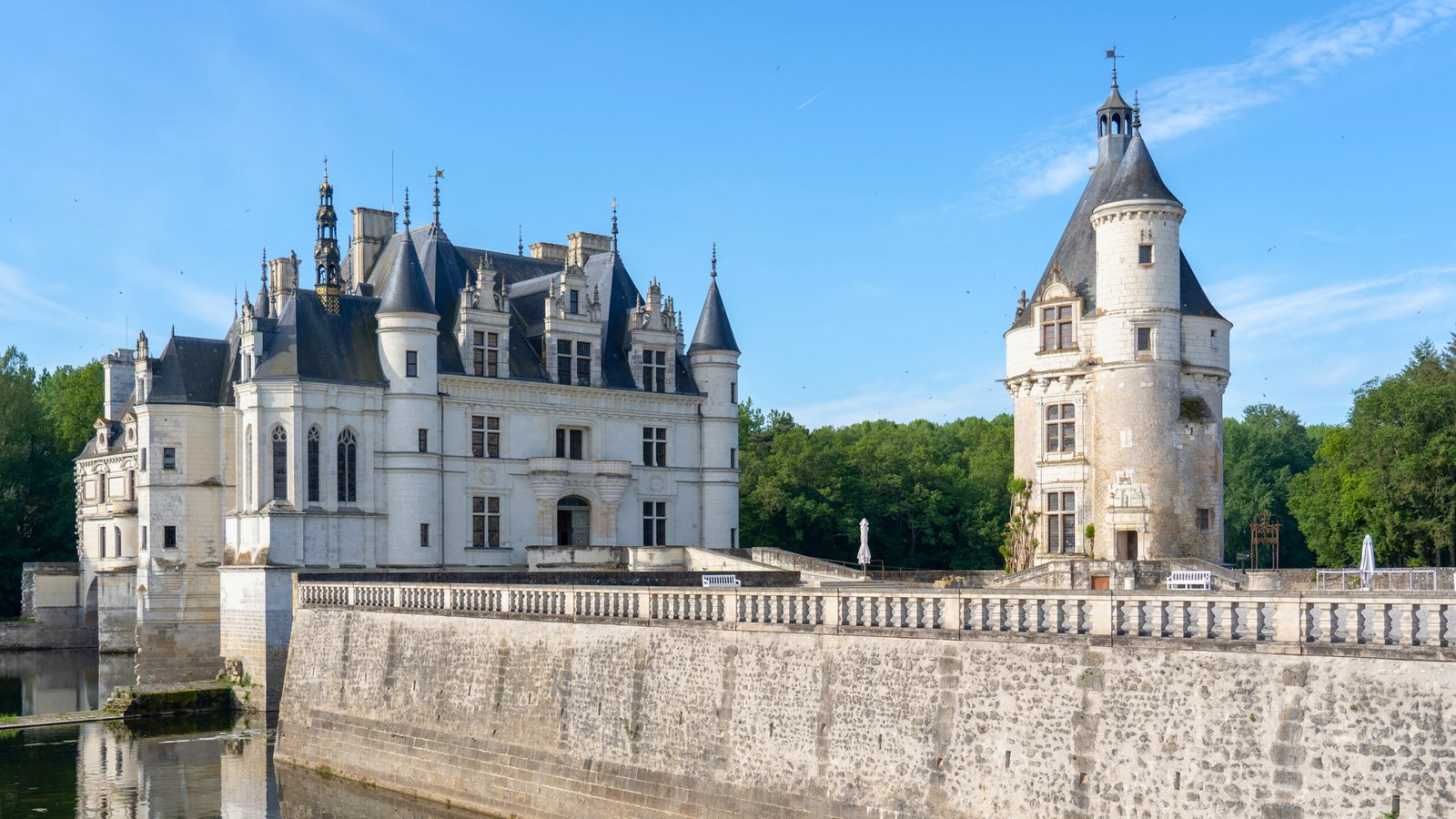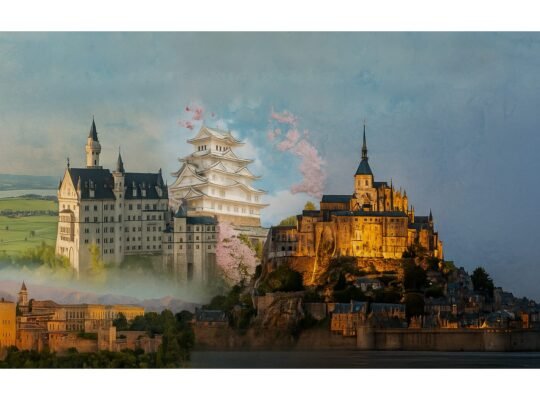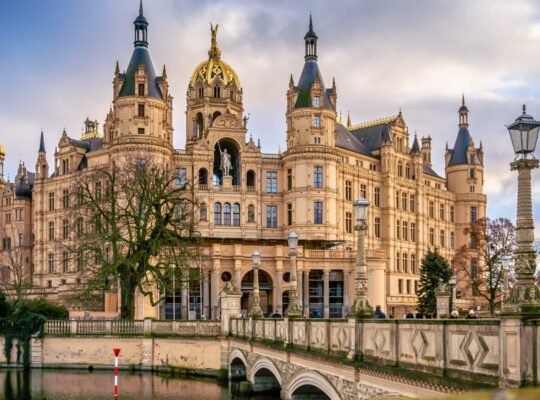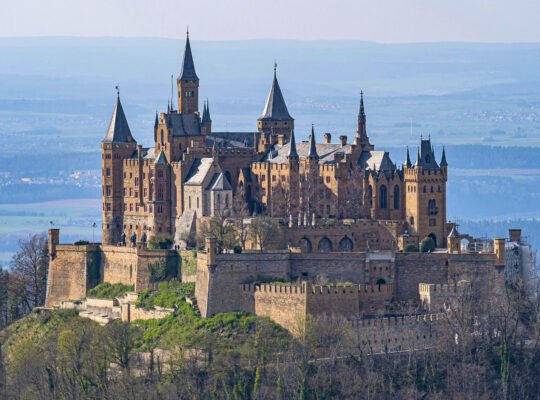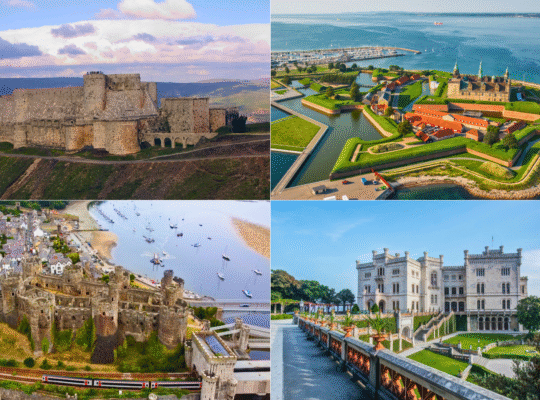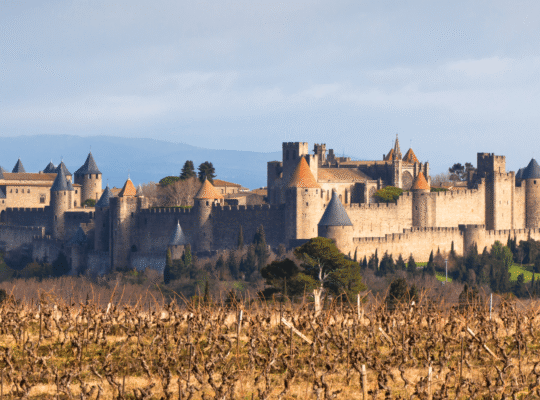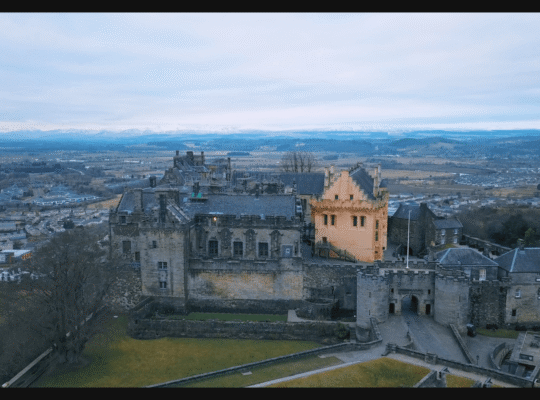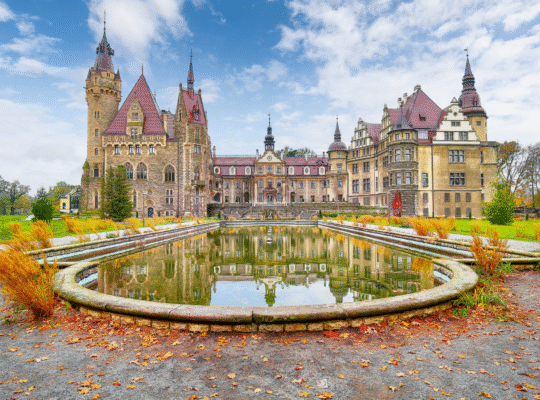The first time I saw the Loire Valley, I was chasing fog.
It was early—too early for most tourists—but I couldn’t sleep. I’d rolled out of bed in a little village near Blois, wrapped a scarf around my neck, and set off toward the river with coffee still warming my hands. The sky was that soft, bluish grey that only exists before sunrise, and the world felt like it was holding its breath.
And then I saw it.
Rising through the low mist like something half-remembered from a childhood fairytale: Château de Chambord. Its towers looked almost weightless in the haze—like they’d floated up from the forest during the night. It stopped me in my tracks. Not just because of its size or its beauty, though it has plenty of both. But because, for a moment, I wasn’t sure if it was real.
That’s the thing about the Loire Valley. It doesn’t overwhelm you. It enchants you—quietly, steadily—until you’re completely under its spell.
Some places try to impress with grandeur. The Loire doesn’t need to. It just unfolds—mile after mile of rolling vineyards, sleepy villages, and castles that appear suddenly around bends in the road, like they’ve always been waiting for you.
And there are so many. More than 300 châteaux, each with its own mood, its own moment in history. Some are austere and moss-covered, clinging to the Middle Ages. Others are Renaissance fantasies, dripping with turrets, gold, and grace. A few feel lived-in. Others feel like they’re still dreaming.
I’ve visited my fair share of castles. But here, they don’t feel like museums. They feel alive. As if somewhere, behind those carved wooden doors, someone just set down a goblet of wine and slipped out to walk the garden paths.
But how do you choose where to begin?
How do you decide which stories to follow in a place where the past speaks from every stone?
Let’s find out.
Quick Facts – Loire Valley at a Glance
📍 Location: Loire Valley, central France
🏗️ Castle Count: Over 300 châteaux along the Loire River
🏰 Famous For: Renaissance and medieval castles, vineyards, gardens
🗺️ UNESCO Status: Yes – Loire Valley between Sully-sur-Loire and Chalonnes (since 2000)
✨ Top Sites: Chambord, Chenonceau, Amboise, Villandry, Cheverny
🍷 Regional Highlights: Wine country, river cycling, cultural festivals
The Magic of the Loire Valley
The Loire Valley isn’t something you visit. It’s something you slowly ease into—like a long sigh after a train ride or the second glass of wine that makes conversation linger longer than planned.
When I think back, I don’t remember the castles first. I remember the light.
It was late spring. The kind of afternoon where the sky forgets what season it’s in and just leans toward blue. I was walking along a narrow country road near Azay-le-Rideau. Buttercups spilled into the ditches, and a woman in a straw hat cycled past me with a baguette in her basket like something out of a postcard. Then came the smell—grass warmed by the sun, river water somewhere just out of sight, maybe jasmine.
And just when I thought it couldn’t get more French, the turrets showed up.
That’s how it happens here. The castles don’t make a scene. They appear gently, like they’re letting you in on a secret. One minute you’re admiring a vineyard; the next, there’s a Renaissance masterpiece tucked between the trees. Not behind gates or fanfare—just there. Almost casual.
But of course, it’s not casual. These châteaux are layered in history and symbolism and centuries of ambition. They’ve seen royal feasts, religious wars, births, betrayals, and long, luxurious summers. And yet they sit quietly by the river, as if they’re simply watching the world go by.
What makes the Loire different isn’t just the architecture. It’s the way the whole place feels alive. Wildflowers push up between the stones. Cyclists wave as they pass. A baker chats with a stranger like it’s the most natural thing in the world. The castles just happen to be there—glorious, yes—but somehow part of the rhythm, not separate from it.
And the river—it’s everything. It moves slowly, like it knows there’s no rush. It curves and curls and keeps the valley stitched together. People walk alongside it, picnic beside it, paint it, write about it. Some just sit and stare.
Honestly, I can’t blame them.
Because the Loire doesn’t overwhelm. It invites. It doesn’t demand admiration—it earns it.
And the magic? It’s not in any one castle or one vineyard or view. It’s in the spaces between. The silences. The small, golden moments that make you wonder if time really does move differently here.
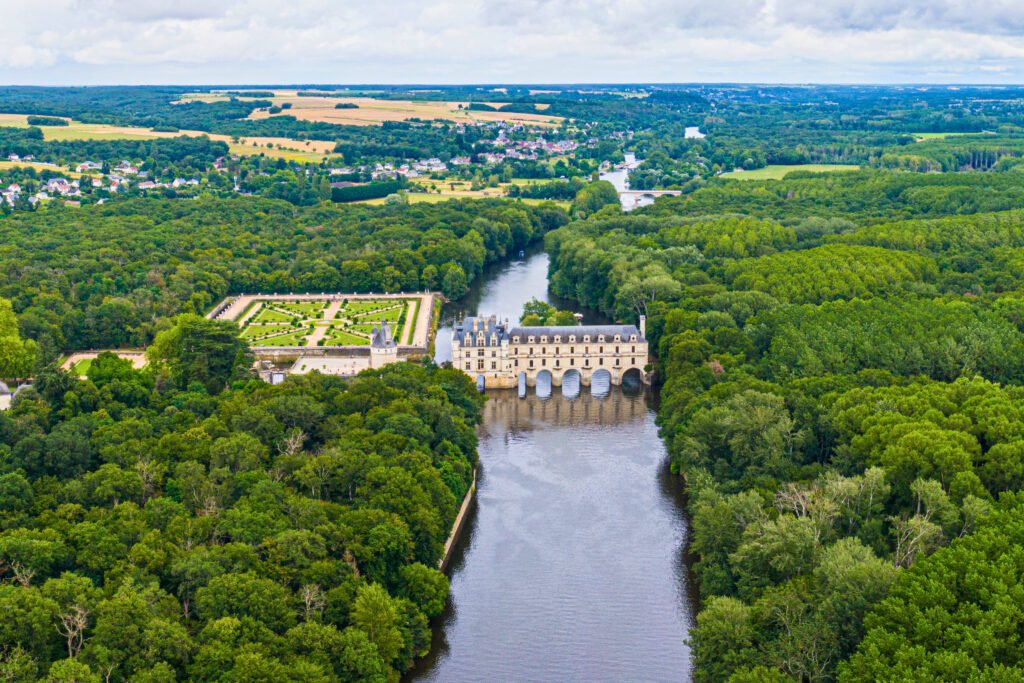
🏰 Château de Chambord — The Loire’s Crown Jewel
You don’t stumble upon Chambord. It announces itself—big, bold, and slightly unbelievable.
I remember thinking, “There’s no way this is real.” We’d just rounded a curve through pine trees and there it was: a skyline of spires, chimneys, and turrets rising like a mirage above the grasslands. It looked less like a castle and more like a fantasy someone forgot to keep in a dream.
Built in the 1500s under King Francis I, Chambord wasn’t a home. It was a statement. A power move. The king didn’t even live here full time—it was more of a hunting lodge. Although calling it a lodge feels like calling Versailles a country cottage.
Now, here’s where it gets curious: Leonardo da Vinci was likely involved. Or at least his sketches were. He died before construction really took off, but the double-helix staircase at the heart of the château? That has Leonardo’s fingerprints all over it—two intertwining spirals where people can climb and descend without crossing paths. Try it. It’s weirdly satisfying.
And the roof… it’s a playground for the eyes. From the upper terrace, you get this sweeping view of towers and chimneys that look like a miniature city built on top of the castle. It’s unlike anything else in France. You half expect to see Rapunzel’s hair tumble out of one of the windows.
Inside, the rooms are grand but surprisingly bare. Maybe that’s part of the appeal—you can imagine it your own way. I stood in the king’s chamber for a while, looking out the tall windows across the estate’s forest. Somewhere out there, deer were probably grazing. It felt oddly peaceful for a palace built to show off.
🎟️ Practical Info:
- Where: Chambord, in the Loir-et-Cher département
- Entry: ~€19 (free for EU residents under 26). Check the official website for the most up-to-date pricing and hours.
- Website: www.chambord.org
- Tours: You can go self-guided, or rent a golf cart to explore the massive park. There are also rowboats and bikes if you're feeling romantic or energetic.
- Don’t Miss: The rooftop terrace just before sunset—trust me on this.
The funny thing about Chambord is that it was never really used the way it was meant to be. It’s too big, too impractical, too remote. And yet… it’s unforgettable.
It’s not just a castle. It’s a monument to ambition. A Renaissance daydream carved into the countryside.
Want the full story behind Chambord’s legendary design and royal secrets? Explore our in-depth guide to Château de Chambord here.
🗺️ See Château de Chambord on the map.
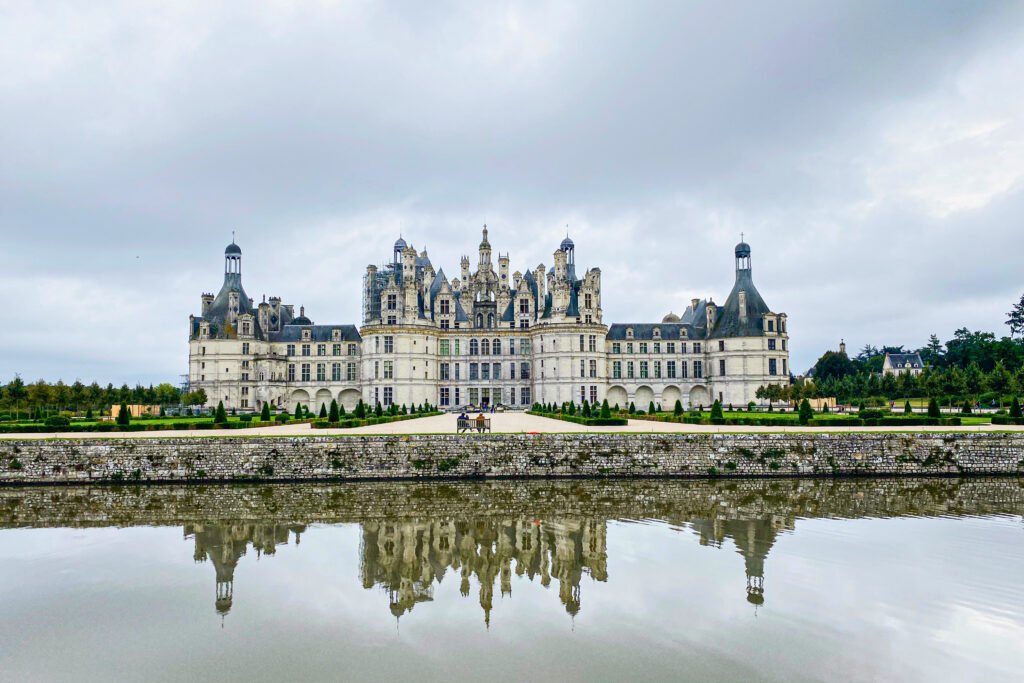
🌉 Château de Chenonceau — The Ladies’ Castle
There’s a moment, just as you approach the footbridge, when you catch your first full glimpse of Chenonceau—and it doesn’t feel quite real.
Maybe it’s the way the arches stretch across the Cher River, like they’re floating. Maybe it’s the way the château’s reflection dances on the water, perfectly still, except for the occasional ripple from a duck. Either way, it stops you. It certainly stopped me. I ended up standing there, halfway between arrival and disbelief, just blinking at it like a tourist who forgot to press “record.”
People call it Le Château des Dames—The Ladies’ Castle—and once you learn its story, the name sticks. This isn’t just a building. It’s a tapestry of powerful women, each one adding a new thread.
Diane de Poitiers, the king’s mistress, was the first to shape it—she commissioned that graceful bridge, planted elegant gardens, and turned it into a vision of harmony. But after King Henri II died, his widow, the formidable Catherine de’ Medici, took it back. Politely at first, then not-so-politely. She made it hers, and she left her mark—adding a two-story gallery over Diane’s bridge that turned it into a river-straddling ballroom.
That detail alone—a ballroom over a river—should be enough to make anyone book a train ticket.
But the story doesn’t stop there. Later came Louise Dupin, who hosted Enlightenment thinkers like Rousseau, and Simone Menier, who ran a military hospital from the château during WWI. That’s the strange and beautiful thing about Chenonceau: it’s not just decorative. It’s resilient. Lived in. Loved.
Inside, it’s warmer than you’d expect. Fresh flowers in every room. Soft light through leaded glass. Tapestries and tiles that look like they’ve been telling stories for centuries. The kitchens, built into the stone foundations beside the river, still smell faintly of iron and herbs. I could’ve lingered there all day.
And outside? Two rival gardens—Diane’s and Catherine’s—still face each other, trimmed to perfection, like they’re locked in a centuries-long competition. You can walk both, of course. I did. Twice. Couldn’t pick a favorite.
🎟️ Practical Info:
- Where: Chenonceaux, Indre-et-Loire
- Entry Fee: ~€18 (gardens and château included). Check the official website for the most up-to-date pricing and hours.
- Website: https://www.chenonceau.com
- Insider Tip: Rent a canoe and paddle under the arches. Trust me, it’s pure magic.
- Nearby: Amboise is a short drive away, perfect for lunch or a market stroll.
Chenonceau doesn’t shout for attention. It doesn’t need to. It’s grace carved in stone, a castle shaped by women who lived boldly and left beauty in their wake.
And once you’ve seen it, you’ll carry it with you—like a song that lingers long after it ends.
🗺️ See Château de Chenonceau on the map.
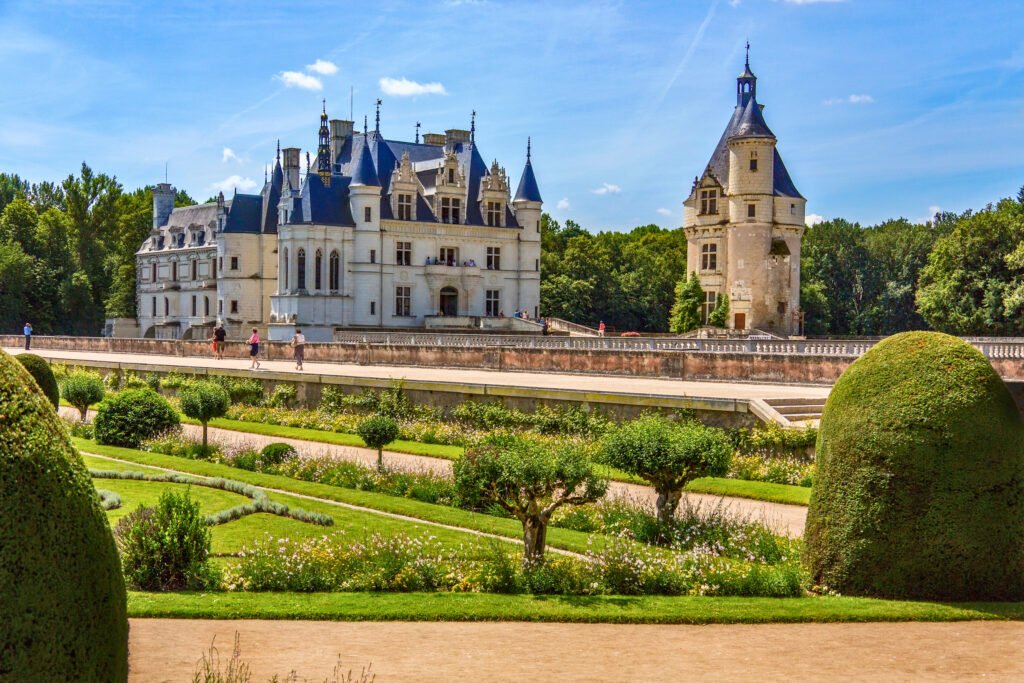
🌿 Château de Villandry — The Gardens of Enlightenment
I didn’t expect a garden to make me emotional. But then again, I wasn’t expecting Villandry.
The château itself is lovely—symmetrical, creamy stone, very tidy in that polished French way—but let’s be honest: it’s the gardens that steal the show. They don’t shout. They glow. I arrived just before noon on a clear June day, thinking I’d walk around for an hour. I stayed for nearly three.
The whole estate is arranged like a philosophy book written in flowers. You don’t just see beauty—you’re asked to think about it. The Love Garden, for example, is laid out in symbolic patterns. Four sections, each one representing a different kind of love: tender, passionate, fickle, and tragic. Yes—tragic. Even the shrubs have a story.
A little over the top? Maybe. But when you're standing there, sun on your shoulders, scent of roses in the air, it all feels oddly sincere.
Then there’s the Ornamental Kitchen Garden, which is… well, stunning. Neatly planted rows of lettuce and chard, alternating colors like checkerboards. It’s so precise it almost doesn’t look real—until you catch a gardener in a straw hat trimming something with hand shears, and you realize this isn’t just for show. People care for this place. Deeply.
From the upper terraces, the view is jaw-dropping. You look down over the whole thing—geometric harmony in every direction—and wonder how anyone ever had the patience or vision to design it.
But here’s the part I didn’t expect: it’s peaceful. Tourists come and go, snapping photos, but there’s a quiet hum to Villandry. A rhythm. Maybe it’s the way the gravel crunches underfoot, or the soft rustling of hedges in the breeze. Or maybe it’s just that the whole place was created not to impress, but to invite contemplation.
🎟️ Practical Info:
- Where: Villandry, Indre-et-Loire
- Entry Fee: ~€14 (château + gardens) or ~€8.50 (gardens only). Check the official website for the most up-to-date pricing and hours.
- Website: https://www.chateauvillandry.fr
- Best Time to Visit: Late spring through early fall, especially early morning or just before sunset
- Nearby Tip: Rent a bike and follow the Loire à Vélo trail to Langeais or Azay-le-Rideau
Villandry isn’t about power or spectacle. It’s about care. Detail. Time. The kind of place that reminds you beauty doesn’t have to be loud to be lasting.
🗺️ See Château de Villandry on the map.
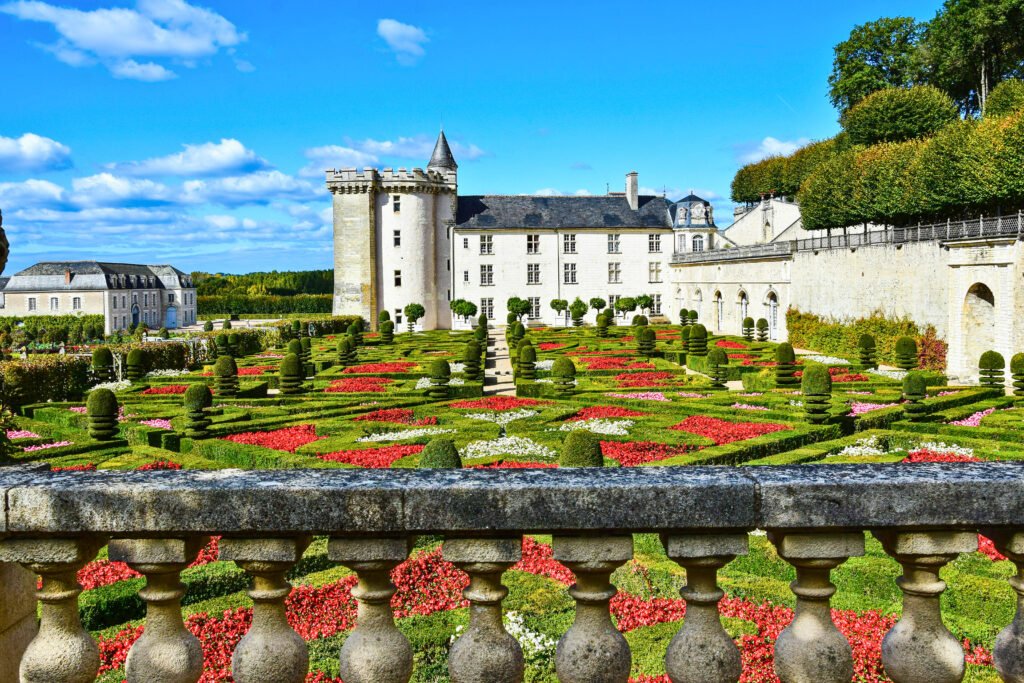
👑 Château d’Amboise — A Royal View of the River
Some castles feel grand. Others feel ghosted. Amboise? It feels lived in—like it still remembers the sound of footsteps and arguments and music echoing off stone.
The town itself is a delight: cobbled streets, bakeries that smell like heaven, and a Saturday market that feels more like a gathering than an errand. But it’s the château that dominates everything. You can see it from nearly every angle of town—perched on a rocky bluff, holding court over the Loire like it’s always been there.
Walking up to it feels like walking into a story. I wasn’t prepared for how high it sits until I looked out from the ramparts and saw the river unwinding below, pale and glassy in the morning light. Boats looked like toys. The rooftops of Amboise curled beneath like something painted.
Historically, Amboise was a favorite of the French kings—Charles VIII, Louis XII, and Francis I all left their mark here. Francis, in particular, had a flair for culture, which explains why he invited a certain Leonardo da Vinci to spend his final years just across the river. Da Vinci lived in a manor called Clos Lucé, and he’s buried here, in the chapel within the castle walls. I wasn’t expecting that to hit me, but it did. Standing beside his modest tomb, I felt a strange kind of gratitude. He chose to finish his life in this gentle place.
Inside the château, there’s that mix of elegance and age: sweeping staircases, patterned tiles worn down by centuries, rooms where the air feels heavier because of all it’s held. One tower, La Tour des Minimes, has a spiraling ramp wide enough for horses and carriages to climb. You can walk it yourself if your knees are feeling brave.
But for me, it was the views that lingered. I sat for a long time near the edge of the upper gardens, just watching the town go about its business below. Church bells chimed. A child laughed somewhere. It felt oddly modern and ancient at the same time.
🎟️ Practical Info:
- Where: Amboise, Indre-et-Loire
- Entry Fee: ~€16.90 (free under age 7). Check the official website for the most up-to-date pricing and hours.
- Website: https://www.chateau-amboise.com
- Must-Do: Visit Clos Lucé while you're here—it’s a short walk and deeply worth it
- Extra Tip: The town’s weekend market is one of the best in the region for picnic goodies
Château d’Amboise doesn’t dazzle with size or sparkle. It holds its beauty in its bones, in its stories, and in the way it lets the past sit beside you without fanfare.
🗺️ See Château d’Amboise on the map.
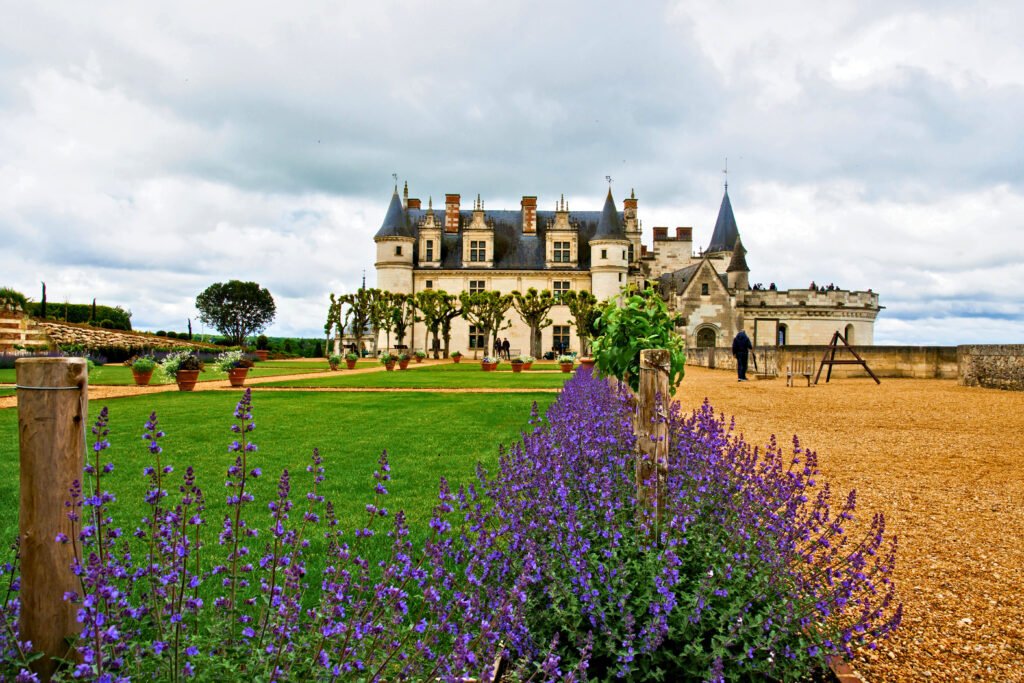
🐾 Château de Cheverny — The Castle That Inspired Tintin
Cheverny was never on my must-see list. Not really. It didn’t have the drama of Chambord or the watery romance of Chenonceau. But as soon as I stepped through the gates, I got it.
This place isn’t flashy—it’s flawless.
Perfectly symmetrical, pristine cream-colored stone, shutters that match, lawns that look like someone irons them. It’s the kind of place where you feel like you should lower your voice and straighten your collar… but in the gentlest way. Not out of fear—just out of respect.
Unlike so many Loire castles that changed hands or fell into disrepair, Cheverny has been lived in by the same family for over six centuries. That continuity shows. The rooms aren’t just preserved—they feel loved. The dining room is set for a banquet you half-expect to be invited to. Bedrooms still wear their silks and embroidery like they were chosen yesterday. Even the nursery has toys. Real ones. Scuffed, like they’ve seen actual childhood.
And then, of course, there are the hounds.
Yes—dozens of them. Sleek, tri-colored hunting dogs that lounge in their own dedicated kennels just outside the castle. When feeding time comes, it’s chaos in the best possible way—tails wagging, paws thudding, food bowls clattering. I stood there grinning like an idiot.
There’s also a delightful twist for the comic-book-inclined: Hergé, the creator of Tintin, modeled Marlinspike Hall after Cheverny. And once you know that, you can’t unsee it. The Tintin exhibition on site is fun and oddly nostalgic—even if you haven’t picked up the books in years.
🎟️ Practical Info:
- Where: Cheverny, Loir-et-Cher
- Entry Fee: ~€15 (includes gardens and Tintin exhibit). Check the official website for the most up-to-date pricing and hours.
- Website: https://www.chateau-cheverny.fr
- Good For: Families, comic fans, lovers of symmetry
- Tip: Don’t miss the kennel feeding (usually around 11:30am)—it’s chaos, but in the best way
Cheverny isn’t trying to be impressive. It just is. Polished but not stiff. Welcoming without being showy. And sometimes, that quiet confidence is the most charming thing of all.
🗺️ See Château de Cheverny on the map.
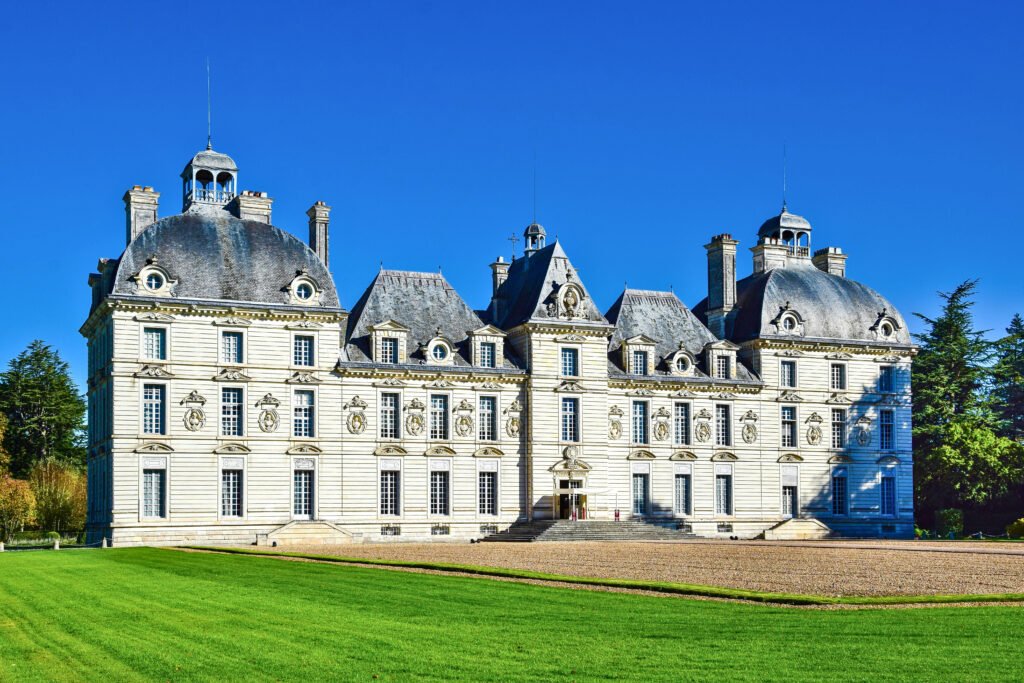
🔥 Château de Chaumont-sur-Loire — Where Art Meets Imagination
You don’t expect to see a castle with a fire garden.
But that’s Chaumont. It does things differently.
Perched high above the Loire, this château could easily play the role of a medieval fortress in a movie—complete with drawbridge, conical turrets, and ivy-draped walls. It has the fairytale silhouette, no doubt. But what makes Chaumont-sur-Loire stand out isn’t just the stone. It’s the spirit.
This place has always drawn visionaries. At one point, it belonged to Catherine de’ Medici (yes, her again), and later to Princess de Broglie, who turned it into a hive of creativity and open-minded elegance. That tradition continues—loudly, boldly, beautifully.
Every year from April to November, Chaumont hosts the International Garden Festival, which is less about gardens and more about ideas. Art spills across the lawns. Giant mirrors lean in meadows. Trees sprout from sculptures. One year, there was a display where flowers bloomed from old books. Another had a tunnel of mist that made you feel like you were walking through someone’s memory.
You’ll wander and wonder. And that’s the point.
Inside, the château holds its own. The rooms are dressed with that blend of faded grandeur and lived-in charm—worn wood floors, soft light, layers of time. It’s elegant without trying too hard. One hallway still smells faintly of beeswax and something older, maybe pipe smoke or polished leather. Or maybe I imagined that. Hard to say.
But step back outside and the atmosphere shifts again. You’re no longer in a historical site—you’re in a conversation. The whole estate is designed to make you feel things, even if you don’t have the language for them.
And when night falls? The installations light up. Trees glow, sculptures hum with color, and the château stands calmly in the background, like it’s been expecting all this brilliance for centuries.
🎟️ Practical Info:
- Where: Chaumont-sur-Loire, Loir-et-Cher
- Entry Fee: ~€21 (château + gardens + festival). Check the official website for the most up-to-date pricing and hours.
- Website: https://domaine-chaumont.fr
- When to Go: April–November for the Garden Festival
- Tip: Wear comfortable shoes—you’ll be walking a lot, and you won’t want to rush
Chaumont is where imagination moves in and makes itself at home. It doesn’t just celebrate the past—it asks what the future could look like, too.
🗺️ See Château de Chaumont-sur-Loire on the map.
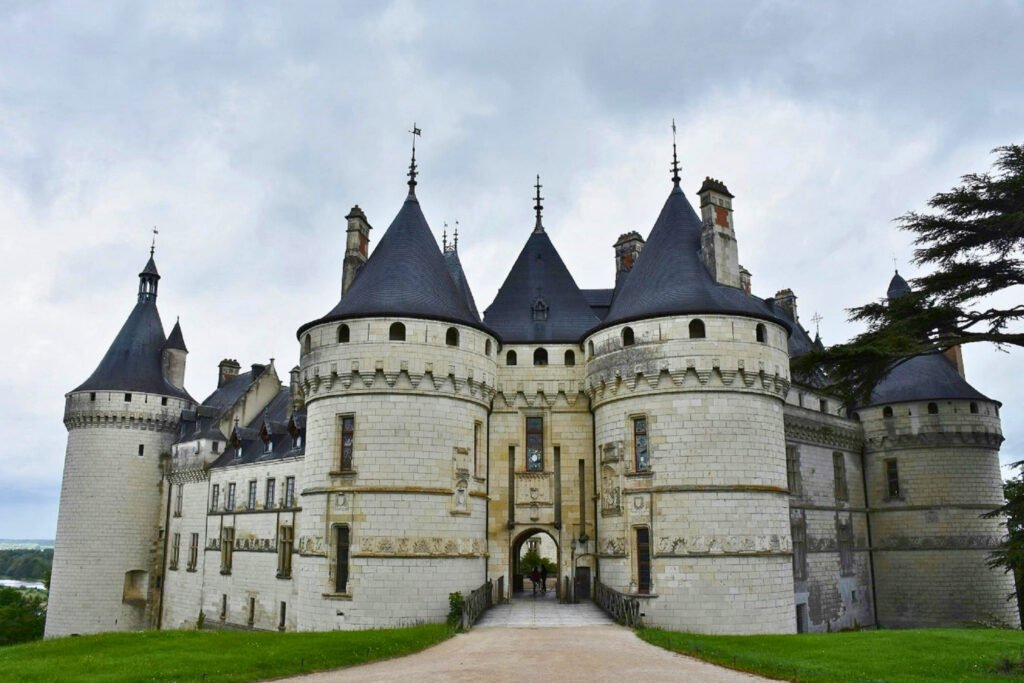
🏛️ Château de Blois — The Architect’s Puzzle
Château de Blois is… well, complicated. And that’s exactly why I loved it.
It’s not the most symmetrical or the most photogenic of the Loire castles. You don’t see it and go, “Ah, fairytale.” You see it and go, “Wait, what’s going on here?” And then you step inside and realize: Blois doesn’t just wear one face—it wears four.
I showed up on a rainy afternoon, which felt oddly fitting. The courtyard was slick with drizzle, and the walls—each from a different era—gleamed in the wet. Gothic, Renaissance, Classical, and Flamboyant—they all coexist in one architectural mash-up. It’s like walking through a time machine designed by a committee.
Historically, Blois was the place to be if you were royal and dramatic. Seven kings and ten queens stayed here, schemed here, ruled here. And not always peacefully. In fact, one of the bloodiest scenes in France’s Wars of Religion happened right inside these walls. Henri III invited Duke of Guise to visit—and then had him assassinated in cold blood. I stood in the very room where it happened. It was colder than the rest. Or maybe that was just my imagination kicking in.
Inside, Blois surprises you. Some rooms are lavish—thick drapes, painted ceilings, gold glinting in the corners. Others feel almost spartan, like time forgot to dress them up. The Francis I staircase is a show-stealer, spiraling outward like some kind of stone seashell. If you like architecture, this place is a gift. If you don’t, it might convert you.
But the best part? The nighttime light show. I had no plans to stay for it—I’d already spent most of the afternoon wandering—but a local told me not to miss it. So I came back after dinner. And honestly, I’m glad I did. They project history onto the castle’s walls: flames, faces, battles, poetry. You stand there in the dark, watching centuries flicker to life right in front of you.
🎟️ Practical Info:
- Where: Blois, Loir-et-Cher
- Entry Fee: ~€14.50 (combo tickets available with Maison de la Magie across the street). Check the official website for the most up-to-date pricing and hours.
- Website: https://en.chateaudeblois.fr/
- Don’t Miss: The sound-and-light show (especially if you’re into weirdly theatrical history)
- Nearby Tip: Blois makes a great base if you're hopping between castles—it’s got charm and train connections
Blois isn’t the prettiest. It’s not the most famous. But if you’re into stories—the messy, tangled kind that history tends to leave behind—it might be the one you remember most.
🗺️ See Château de Blois on the map.
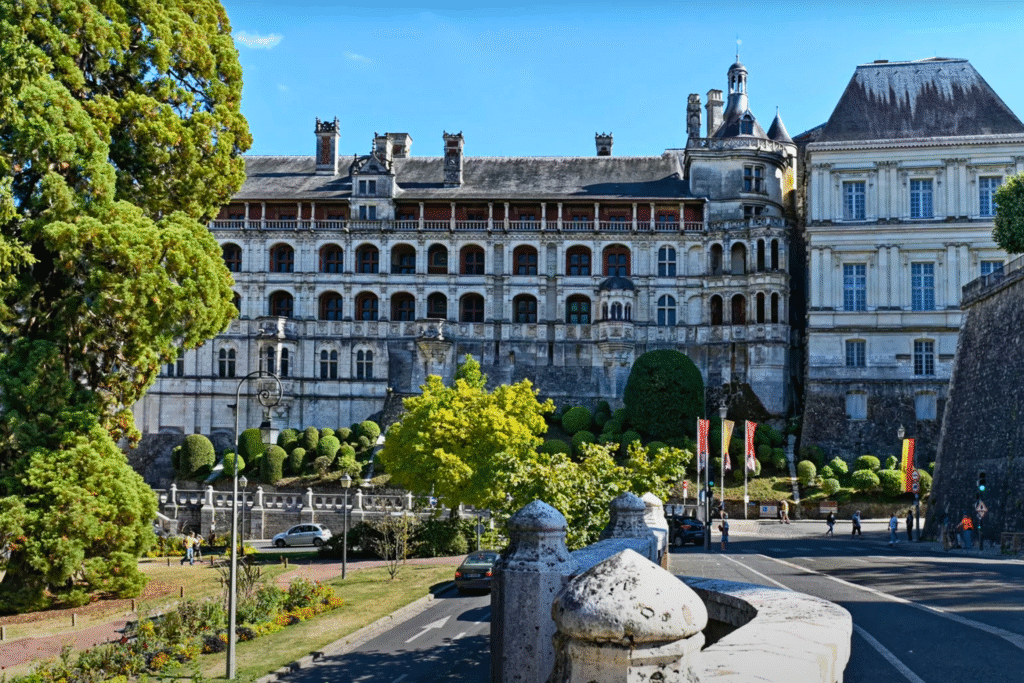
💤 Château d’Ussé — The Sleeping Beauty Castle
You know how some places don’t just look like a fairytale—they feel like one?
That’s Château d’Ussé.
Even before I saw the sign, I had a feeling. There was something in the way the road narrowed under arching trees, the way the ivy clung to the stone wall just a little too perfectly. And then the towers appeared—white, turreted, delicate as frosting. I actually said “wow” out loud. Quietly. To no one.
This is the castle that inspired Charles Perrault’s Sleeping Beauty, and honestly, it makes sense. The place looks like it’s waiting for a princess to wake up and a prince to show up late. Everything about it is dreamy and just slightly too perfect—like a movie set that never got torn down.
But Ussé isn’t just a pretty face. Its history goes back to the Middle Ages, though most of what you see today was built between the 15th and 17th centuries. Over time, it evolved—from fortress to residence, from strategic to romantic. And that’s kind of what makes it special. It’s soft around the edges.
Inside, it’s quiet. Some rooms are ornate and museum-like, others feel like someone might still live there. And then you reach the towers—the part where the fairy tale lives. There’s a walkway lined with Sleeping Beauty tableaux, complete with wax figures mid-slumber or dramatically pointing toward spinning wheels. Yes, it’s a little kitschy. And yes, it’s also kind of wonderful. Especially if you lean into it.
The chapel, designed by the same architect who worked on Versailles, is tucked into a quiet corner of the grounds. It’s not flashy, but it has this soft light that makes you want to sit for a while. The Le Nôtre-designed terraces below are neat and peaceful, with views out over the forested hills that once held more mystery than map.
🎟️ Practical Info:
- Where: Rigny-Ussé, Indre-et-Loire
- Entry Fee: ~€14.50; open mid-February to mid-November. Check the official website for the most up-to-date pricing and hours.
- Website: https://www.chateaudusse.fr
- Good For: Families, fairy tale lovers, anyone secretly hoping for enchanted turrets
- Nearby Tip: Stop in Chinon on your way—good wine, medieval charm, and fewer tourists
Château d’Ussé might not have the scale of Chambord or the fame of Chenonceau, but there’s a softness here that stays with you. Something gentle. Familiar. Like the memory of a story you half-remember from childhood, retold in stone and ivy.
🗺️ See Château d’Ussé on the map.
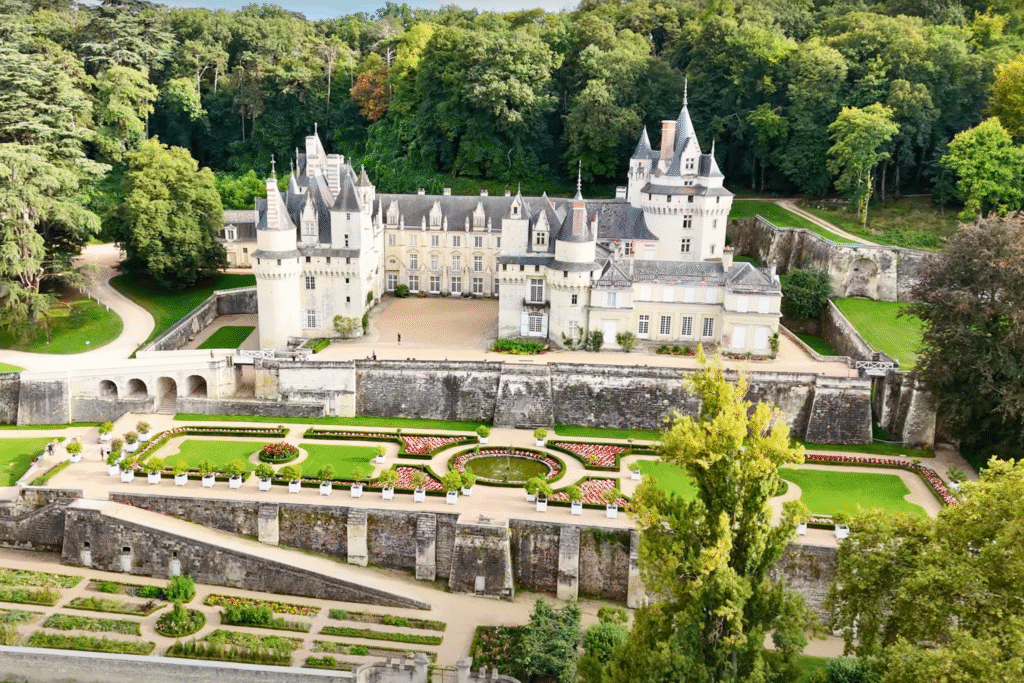
🏇 Château de Saumur — The Castle of Cavaliers and Contrasts
Some castles brood. Others boast. Saumur does neither—it stands. Solid, pale, confident, perched high above the town like it knows exactly who it is.
I first saw it from across the river, just after a rainstorm. The clouds were still breaking up behind it, and the stone almost glowed against the sky. I remember pulling over without thinking, hopping out of the car, and just… staring. The view felt like a painting someone had forgotten to frame.
Originally built in the 10th century as a fortress, Saumur has worn many hats: royal residence, military barracks, prison, and now museum. It doesn’t feel overly polished, and that’s part of the charm. There’s a certain honesty to it—a castle that’s worked hard and still holds itself with grace.
Inside, there’s a museum dedicated to decorative arts and horses. Yes, horses. This town is famous for its equestrian legacy, thanks to the Cadre Noir, France’s national riding academy. The museum holds centuries’ worth of saddles, uniforms, bits, stirrups—objects that feel surprisingly personal when you see them up close. I’m not a horse person, but even I found it fascinating.
And the view from the ramparts? Unbelievable. You get the entire town at your feet—the bridge, the river, the rooftops—plus the endless horizon of vineyard-covered hills rolling toward Chinon. Bring a camera. Or don’t. Just be still for a while. That’s what I did.
There’s a quiet dignity to Saumur. It doesn’t crowd you with interpretive panels or flashy reconstructions. It just is. It lets you fill in the story with your own imagination.
🎟️ Practical Info:
- Where: Saumur, Maine-et-Loire
- Entry Fee: ~€9.50; combo tickets available with local museums. Check the official website for the most up-to-date pricing and hours.
- Website: https://www.chateau-saumur.fr
- Don’t Miss: The rooftop views and the horse museum (even if you think you’re not into horses)
- Nearby Tip: Sample sparkling Saumur brut at a local cave—many are carved into the tufa cliffs just beneath the town
Château de Saumur doesn’t need to be dramatic to leave an impression. It’s the kind of place that doesn’t shout for your attention—and somehow ends up holding it the longest.
🗺️ See Château de Saumur on the map.
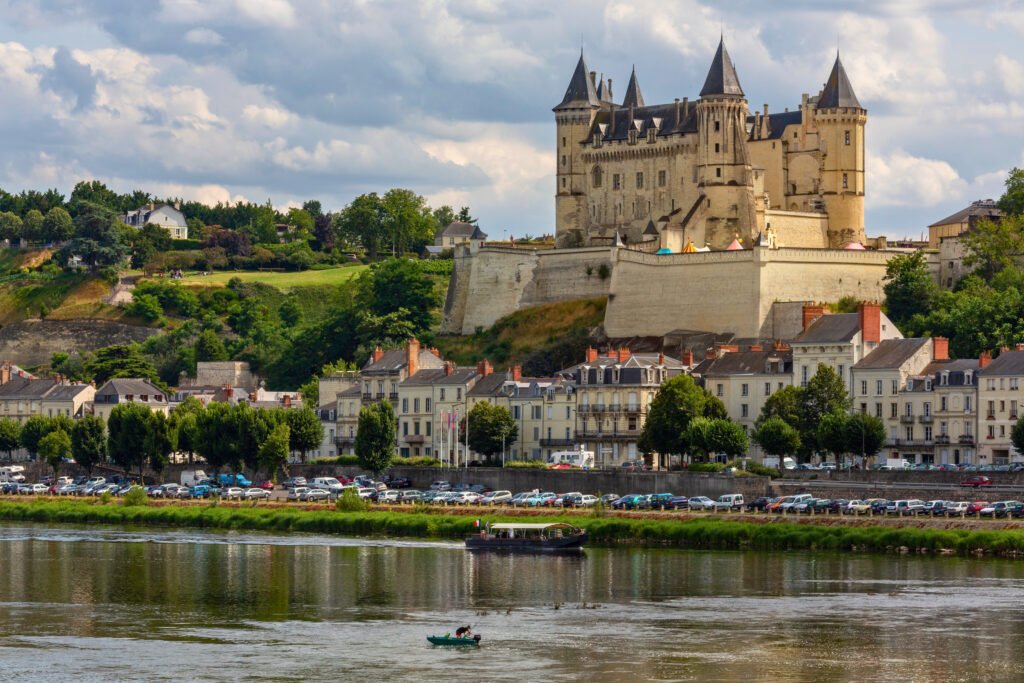
🖼️ Château de Montsoreau — Where the River Meets Contemporary Art
If you like your castles with a side of surprise, Château de Montsoreau might just be the one that sticks in your memory.
It certainly caught me off guard.
You see the name on a map, figure it’ll be another lovely old pile of stone with turrets and maybe some tapestries. What you don’t expect is to walk into a 15th-century château and find contemporary art installations glowing in whitewashed halls and quotes scrawled across walls in bold black type.
Montsoreau is different. Right from the start.
It’s the only château in the Loire Valley built in the river. Not next to it. Not near it. In it. The Loire literally brushes up against its base like it’s trying to whisper something. And when the light hits just right, the whole place glows from below.
Historically, it was built by Jean II de Chambes, a royal courtier under King Charles VII, and it was certainly a place of power and prestige in its day. But what it is now… is something else entirely.
Today, Montsoreau houses the Musée d’Art Contemporain, home to the world’s largest collection of works from the Art & Language movement—a conceptual art collective that challenges what art is, how we experience it, and how we talk about it. It’s heady stuff. Some of it is beautiful, some of it is strange, and some makes you squint and mutter, “What am I looking at?” (That’s half the fun.)
I wandered from room to room not quite sure what I’d find next. One minute, a view of the river through medieval windows. The next, a neon sculpture or a philosophical provocation written in chalk. It felt like the castle and the art were in constant dialogue—and I was just lucky enough to overhear it.
Outside, the town of Montsoreau is impossibly pretty. Cobbled streets, ivy-draped houses, and a rhythm that slows your pulse whether you want it to or not. There’s a brocante (antique market) on Sundays that’s worth a wander—even if you’re not looking to buy anything.
🎟️ Practical Info:
- Where: Montsoreau, Maine-et-Loire
- Entry Fee: ~€12 (includes castle and museum access). Check the official website for the most up-to-date pricing and hours.
- Website: https://www.chateau-montsoreau.com
- Open: Year-round, closed Tuesdays in winter
- Nearby Tip: Take a short walk along the riverside to Candes-Saint-Martin, one of the most beautiful villages in France
Montsoreau may not be the grandest château on the list, but it might be the boldest. It’s where the past opens its doors to the present—and somehow, they both fit.
🗺️ See Château de Montsoreau on the map.
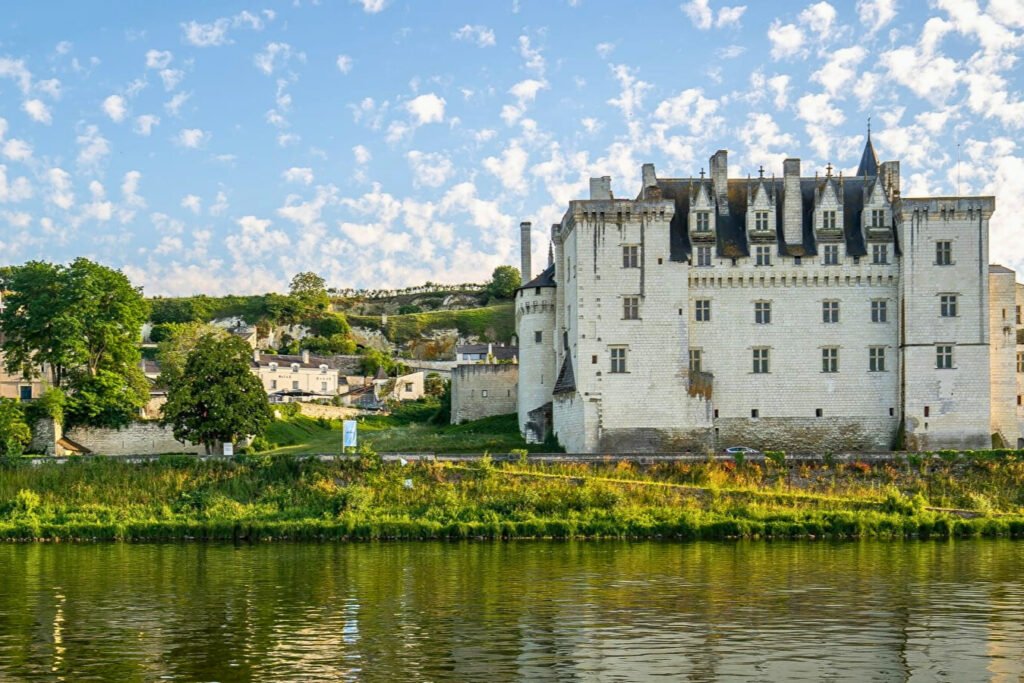
Planning Your Loire Valley Adventure
Let’s be honest—dreaming about the Loire is easy. Actually planning it? That’s where things get a little overwhelming. So many castles, so many villages, and let’s not even talk about how hard it is to choose between sleeping in a medieval town or in a château with its own vineyard.
I’ve been there. Literally.
Here’s what I’ve learned from wandering through the region with a map half-folded in my backpack and croissant crumbs in my pocket.
📍 Getting There (Without Losing Your Mind)
If you’re starting in Paris, good news: the Loire Valley is closer than it seems. You can hop on a TGV train and be sipping wine in Tours or Blois in under two hours. The French train system is surprisingly civilized like that.
- By train: Fast, comfortable, and the easiest way to reach major towns like Tours, Amboise, and Angers.
- By car: Best if you want to reach off-the-beaten-path castles or stay in tiny villages. The roads are smooth, the scenery is calming, and yes, roundabouts are everywhere.
- By bike: If you’re the kind of traveler who finds joy in pedaling past vineyards and wildflower meadows, look into the Loire à Vélo trail. It’s scenic, flat, and full of charming detours.
🚗 Note from experience: Rent the smallest car you’re comfortable in. Some village streets are tight, and parking near popular castles can be a puzzle.
🏨 Where to Stay (and Why You Might Never Leave)
Here’s the thing: you can sleep in a château. Like, an actual one. With turrets and tapestries. But even if you don’t go full fairytale, the Loire offers a wonderful range of places to rest your head.
- Tours: A solid home base—bustling but not overwhelming, with lots of cafés, bakeries, and easy transport links.
- Amboise: Feels like stepping into a storybook. Cobblestone streets, a hilltop castle, and great riverside wine bars.
- Saumur: Quieter and a bit more laid-back. Great for wine lovers, equestrian fans, and long walks by the water.
- Château stays: Yes, they exist. Yes, they’re magical. Try Château de Beaulieu or Château des Arpentis if you want that “I woke up in another century” feeling.
💡 Tip: Book early if you’re visiting in spring or autumn—especially during festivals or long weekends. The secret’s out.
🍷 What to Eat (and Definitely Drink)
This region isn’t just about castles. It’s also about wine. And cheese. And bread. And then more wine.
- Wine regions to know: Vouvray (elegant whites), Chinon (earthy reds), Saumur (sparkling).
- Local specialties: Try rillettes (like a fancy pork spread), goat cheese from Sainte-Maure, tarte Tatin (the upside-down apple tart that’ll ruin you for all others).
- Picnic culture: Strong. Hit a local marché (market), grab a crusty baguette, some cheese, and wine, then find a shady spot near a château. Voilà—French perfection.
🧺 Pro move: Always carry a corkscrew and napkin. You’ll thank me.
🚴 Getting Around
There’s no one right way to explore the Loire—only the one that suits your rhythm.
- Driving gives you freedom, especially for harder-to-reach castles like Montsoreau or Ussé.
- Cycling the Loire à Vélo is dreamy and well-marked, with plenty of places to rest, eat, or take a wine break.
- Day tours are great if you’re short on time. Lots depart from Tours or Amboise and include a few castles and wine tastings.
- Public transit exists—but it’s a bit patchy in the countryside. Trains work between bigger towns, but don’t expect to hop on a bus to every château.
🚲 Note: Some castles (like Chambord) even rent bikes or electric scooters. Yes, you can ride around royal hunting grounds. Yes, it’s as fun as it sounds.
📅 Best Time to Visit (aka When the Magic Happens)
The Loire is beautiful year-round, but let’s break it down:
🌸 Spring (April–June): Wildflowers, perfect temperatures, fewer crowds. My favorite.
☀️ Summer (July–August): Lush, buzzing, and full of festivals—but also full of tourists. Book everything ahead.
🍂 Autumn (September–October): Grape harvest, golden light, crisp air. Hard to beat.
❄️ Winter (Nov–March): Quieter, but many castles have limited hours or close for the season. That said, some offer magical Christmas lights and fewer lines.
🌟 Bonus: Keep an eye out for the Chaumont Garden Festival and Villandry’s candlelit evenings—both feel straight out of a dream.
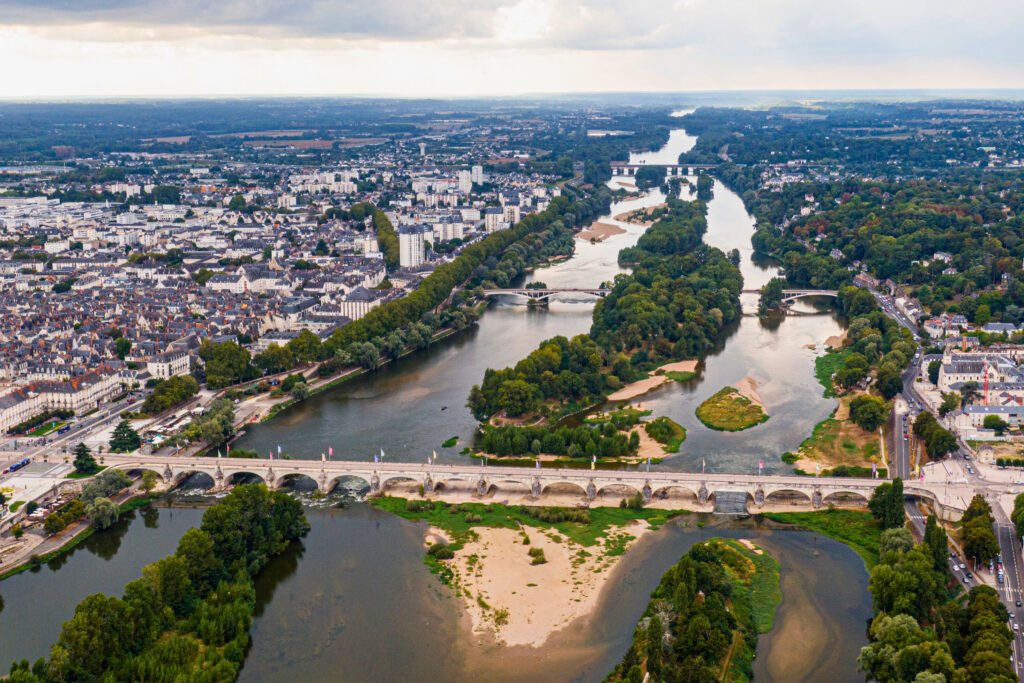
Beyond the Castles – What Else to Do in the Region
So, let’s say you’ve wandered through enough turrets and throne rooms to last a lifetime. You’ve admired gardens, climbed spiral staircases, and maybe even had a picnic near a moat. What now?
Well, the good news is the Loire Valley doesn’t stop at castles. In fact, some of my favorite moments had nothing to do with royalty.
Here’s what else to soak up while you’re in the region.
🍷 Wine Tasting in the Land of the Grape
If you leave the Loire without sipping at least one glass of Vouvray, Chinon, or Saumur, did you even visit?
This valley is serious about its wine—but not in a stuffy way. You can walk into a family-run cave carved straight into the limestone hills and end up chatting with the winemaker over a glass poured just for you.
- Vouvray: White, floral, sometimes sparkling. It’s what summer tastes like.
- Chinon: Earthy reds and dry rosés that pair well with almost everything.
- Saumur: Great for sparkling lovers, especially if you like your bubbles with a bit of French countryside charm.
🍇 Tip: Most tastings are free or low-cost, but a small purchase is always appreciated—and totally worth it.
🛶 Paddle the Loire or Cruise Like Royalty
The Loire River isn’t just a scenic backdrop—it’s a part of the story.
- Canoeing: I did a half-day paddle under the arches of Château de Chenonceau once. Yes, it was as magical as it sounds. Peaceful, gentle current, dragonflies skimming the surface.
- Boat cruises: Great from Amboise, Saumur, or Montsoreau. Think slow, relaxing, maybe with a glass of wine as the sun dips low.
🚣 Real talk: You don’t need to be sporty. The river is calm, and most canoe rentals include transport so you don’t have to paddle back.
🌺 Gardens, Art, and Open-Air Wonder
Castles have gardens. But here? Gardens sometimes are the main event.
- Chaumont-sur-Loire’s Garden Festival (April–Nov): Wild, whimsical, sometimes weird—but always memorable. Think flower beds shaped like labyrinths, installations with mirrors, and things that make you pause and say “huh… but I kind of love it.”
- Villandry by Candlelight: On summer evenings, the château lights thousands of candles in the garden. It’s unreal.
- Terra Botanica (near Angers): If you’re with kids—or just want to nerd out about plants—it’s interactive, colorful, and surprisingly fun.
🌻 Local tip: Even in small towns, you’ll stumble across hidden courtyard gardens open to the public. They’re usually marked with tiny hand-painted signs and totally worth exploring.
🎈 Hot-Air Balloon Rides (Because Why Not?)
If you’ve ever dreamed of floating above vineyards and castles while the sky turns pink around you—this is your moment.
- Best spots: Amboise, Chenonceau, Saumur.
- Best time: Sunrise. The stillness is something else.
- What to expect: It’s quiet, almost eerily so, except for the occasional burst of flame as the pilot adjusts the heat. You’ll drift slowly. Below, the Loire sparkles, fields stretch forever, and castles peek out from the trees.
🎈 Note: Most rides end with a glass of bubbly. It’s tradition. (And honestly, who’s saying no to that?)
🧺 Market-Hopping & Local Finds
Every village seems to have its own market day, and they’re worth hunting down. Think honey jars, goat cheese wrapped in chestnut leaves, baskets of cherries, lavender soaps, and the kind of bread that makes you question everything you thought you knew about carbs.
- Amboise (Sunday): Big, lively, right by the river. Great for picnic supplies.
- Loches (Wednesday & Saturday): More local, less touristy. Amazing cheese stalls.
- Chinon: Markets here feel like you’ve stepped into a novel—old stone, shaded squares, accordion music if you’re lucky.
🎒 Don’t forget: Bring a tote bag and a few euros in cash. And give yourself time—these markets aren’t just for shopping, they’re for wandering.
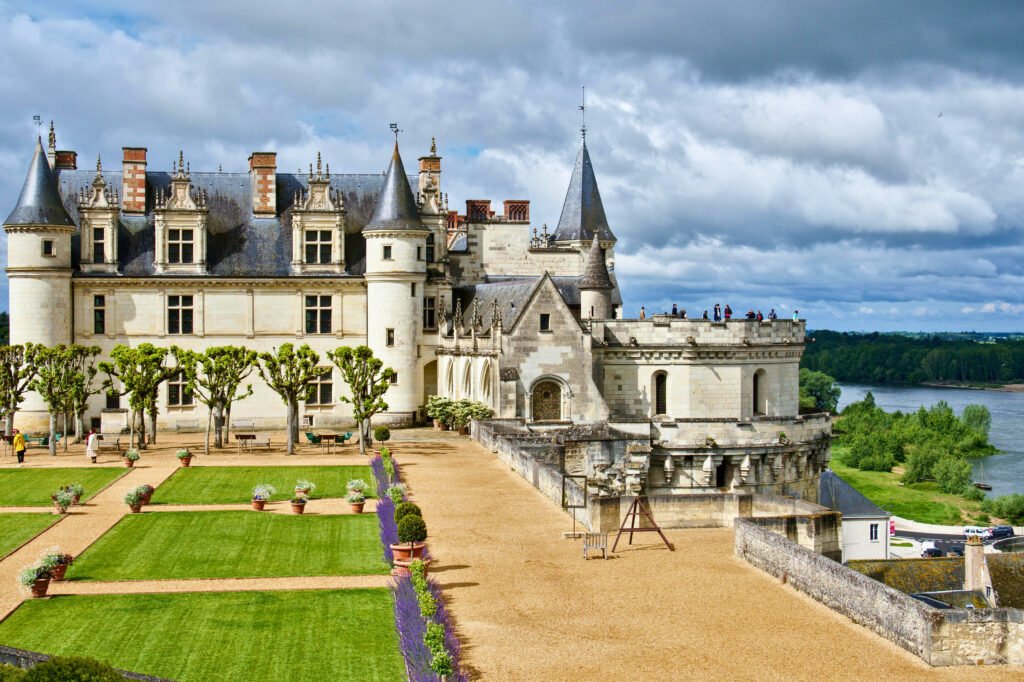
Final Thoughts
I didn’t realize how much the Loire Valley had gotten under my skin until I left it.
One minute you’re walking through the gardens of Villandry, the next you’re stuck in traffic outside Paris, and it hits you—that shift. That slowness you felt for days? It’s already starting to fade. The air was softer there. The light lingered longer. Meals stretched out into conversations. Even the castles—grand as they were—never felt like they were showing off. They were just… there. Rooted. Timeless.
The Loire doesn’t demand anything from you. It doesn’t overwhelm or exhaust. It just invites you in. To slow down. To look closer. To listen—whether it’s to the wind through poplars, the clink of wine glasses on a picnic table, or the creak of an old wooden door in a château that hasn’t changed in centuries.
I think that’s what makes it so hard to forget. You come for the castles. But you remember the quiet. The stillness between moments.
And the truth is, you don’t need to see all 300+ châteaux. You don’t even need to see ten. Just pick a few. Let them surprise you. Get lost on a side road. Sit by the river. Buy too much cheese at the market. That’s how the magic happens.
Because in the Loire Valley, time doesn’t race forward—it flows.
And the past never feels far away.
💬 Have you wandered through France’s château country? Tell us your favorite discoveries, surprising moments, or hidden gems in the comments. Or better yet—tag @CastleQuestChronicles on Instagram so we can follow along on your Loire adventure.
✨ Still chasing the echoes of royal footsteps? Step into imperial elegance with our deep dives into Palace of Versailles and Vienna’s majestic Schönbrunn Palace.
📸 And if this article sparked your curiosity about the castles, follow along. We are on Instagram, Pinterest, Facebook, and X, too. More castles (and more stories) are just around the bend. Explore all our castle adventures here!

